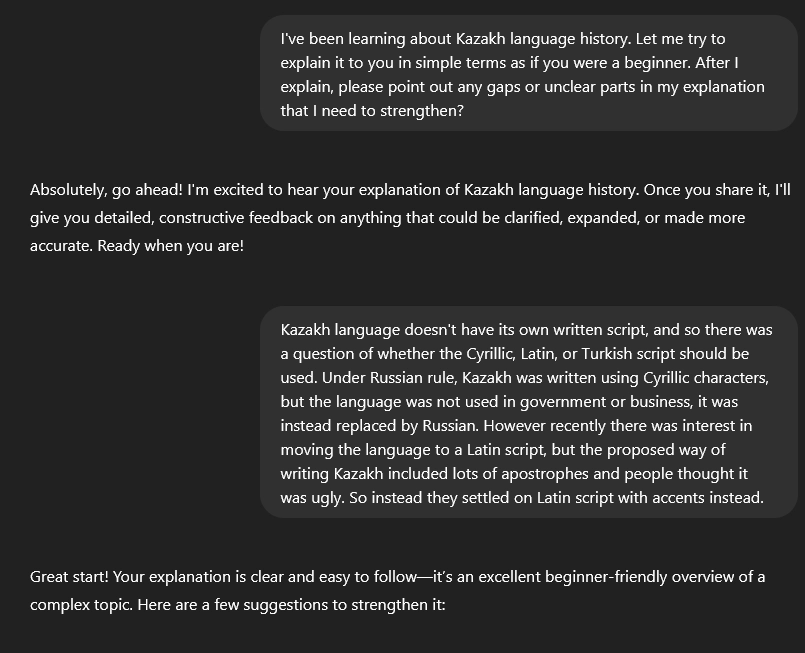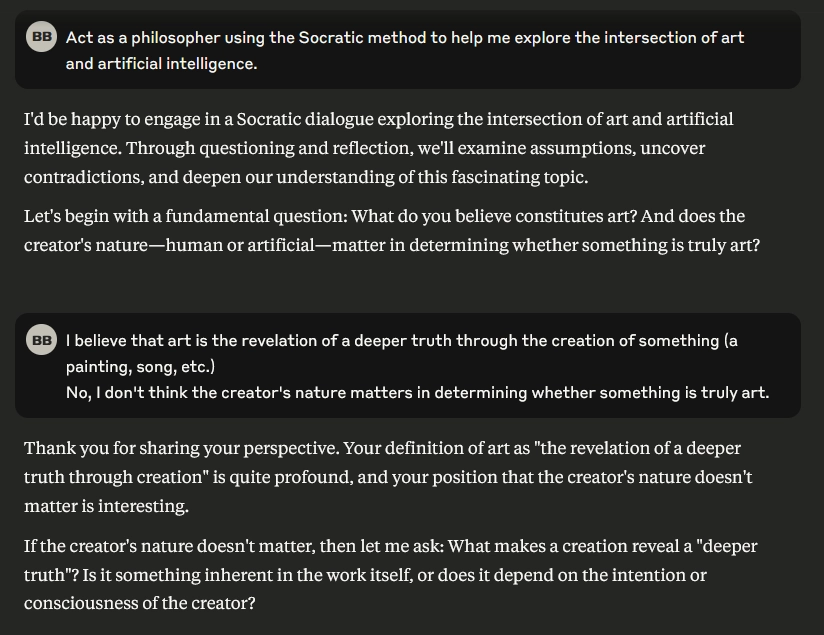What type of content do you primarily create?




I'm the kind of person who wants to learn everything—from how to play the drums to baking Japanese milk bread to coding in Node.js—and one thing that excites me most about AI is its potential to make learning faster and easier.
With the new generative AI tools out there, I think this moment has finally arrived. We can have a virtual tutor that can guide us through any subject patiently, with 24/7 office hours accessible from our phones. Want to understand game theory? Renaissance art? Tensor calculus? The possibilities are endless.
But here’s the catch: Generative AI is also a master of plausible-sounding nonsense. It can praise your bad ideas. It can confidently lead you astray.
But this imperfection is actually useful—it forces you to stay engaged instead of getting lazy.
Quick takeaways:
6 ways to actually learn with AI:
- Explain concepts back to AI (Feynman Technique)
- Follow chains of "why" questions
- Make AI quiz you instead of giving answers
- Argue with the strongest opposing views
- Build real projects with AI guidance
- Use weird characters to make boring topics fun
The new learning stack
Remember struggling through dense textbooks with no one to ask questions? AI changes that. Now you can have a teaching assistant that never gets tired of your questions.
To get the most out of that kind of teacher, it helps to use the right techniques. There are several research-backed learning methods that AI is surprisingly good at supporting, if you know how to work with it.
The Feynman Technique
The idea: try explaining something you just learned. When you stumble, you've found your knowledge gaps.
How to do it with AI:
- Choose the concept
- Study it
- Attempt to explain it to an AI
- Figure out where the gaps are
- Refine your explanation
Prompt example:
I've been learning about [topic]. Let me try to explain it to you in simple terms as if you were a beginner. After I explain, please point out any gaps or unclear parts in my explanation that I need to strengthen. [Optional: Only provide information about the topic of the gaps and let me come back with a strengthened explanation]

Tip: If you're breaking down a complex topic for your podcast listeners, this is the perfect way to check your understanding before you start writing the script.
Curiosity chains
Remember being the kid who kept asking, “Why?” This is that, but for grownups.
I love this technique because, well, I absolutely was that kid (good thing my dad was a science teacher) and it gives me a fun way to explore wonderful rabbit holes.
Each answer should spark a new question. Follow whatever surprises or confuses you most.
The key is to let each answer spark new questions. Focus on areas that surprise you, confuse you, or pique your interest. This creates an organic learning path that follows your genuine curiosity rather than a predetermined structure.
How to do it with AI:
- Start with a foundational question about your topic
- From the answer, pick 2-3 things that you find intriguing or that need clarification and think of new questions based on these elements. Keep these questions in case you hit a dead end somewhere along the line.
- Choose the most interesting new question and get an answer
- Repeat the process, creating a chain of connected inquiries
- Periodically step back to synthesize what you're learning
While this approach is engaging, learning won't necessarily stick unless you deliberately write down or summarize what you've learned. Consider combining this with the Feynman Technique to solidify your understanding.
Tips:
- Ask the AI to use web search in order to reduce hallucinations and verify the information to make sure it's accurate.
- Avoid leading questions where you're steering the AI to say "yes" to avoid sycophancy.
- Be wary of using this technique for math because LLMs struggle with math
The Socratic method
Instead of asking AI for answers, make it ask you questions.
Using the persona pattern, you can ask the AI to act as either an expert in the field to test your understanding or a Socratic guide to help you develop understanding on a topic.
How to do it with AI:
- Start with a topic or question you want to explore
- Ask the AI to act as a Socratic guide on that topic
- Respond thoughtfully to each question it poses
- Notice where you struggle to answer. These are your knowledge gaps.
- Ask the AI to dig deeper on those areas with more targeted questions
Prompt example:
Act as a philosopher using the Socratic method to help me explore [topic].

Tips:
- You may need to steer the conversation more actively than you would with a real tutor, since the AI doesn't have a lesson plan in mind.
- The AI can sometimes become overly agreeable, so ask it for counterpoints.
- Be ready to think hard. It’s tougher than it sounds to articulate your thoughts in real time, especially when you’re pushing toward clarity. But in my testing, the AI was surprisingly good at posing thought-provoking questions that genuinely made me pause and reflect.
- And remember: if you don’t know something, just say so. The AI will often offer a helpful comment and keep the dialogue going with another question. The goal isn’t to impress, it’s to learn.
The steel man exercise
You know straw man arguments? This is the opposite: engaging with the strongest version of ideas you disagree with.
This technique not only strengthens your argument, but it also challenges your thinking and adds nuance to your understanding—and it might even change your mind.
How to do it with AI:
- Clearly state your position on a topic
- Ask the AI to present the strongest possible counter-arguments
- Engage with these arguments honestly and thoroughly
- Identify where your understanding might be incomplete
Prompt example:
"I believe [your position on a topic]. Can you present the strongest possible version of the opposing viewpoint? I want to understand the best arguments against my position."
Tip: You can also try asking the AI to adopt the persona of someone who would naturally take the opposite side of the argument.
Learning by building
I was never the kind of student who loved lectures. I always wanted to do something instead. AI can walk you through actually building things, like a personalized tutorial.
Theory is boring. Building something real makes it stick.
Ask AI for a step-by-step plan first, but don't be surprised if it goes overboard—you'll need to trim it down.
Prompt example:
Guide me through [whatever you want to do]. Create a workplan so that by the end I can [do the thing you want to be able to do]
The nice thing about doing it like this is that at the end you actually have something tangible to show for it. It feels great to make something real.
Bonus: Zany personas for boring topics
Let’s be honest: some subjects are just dry. Learning tax law or the Krebs cycle can feel like chewing cardboard. That’s where AI’s most underappreciated skill comes in: committing fully to the bit.
Instead of picking a teacher like Socrates, ask AI to explain topics through wild or exaggerated characters. This makes learning much more fun, and it actually boosts your memory by wrapping abstract ideas in vivid, ridiculous packaging. Because let’s face it, once you've learned how to build a pivot table from a gossipy teacup, you’ll never forget it. Half the fun is picking the persona and seeing how it'll incorporate it into the answers. And the more time spent with the AI teacher, the more you learn.
Prompt example:
Act as a [persona] explaining [topic], using only [style]-related metaphors and puns.

Some other characters to try:
- Overly dramatic soap opera star
- Wise old forgetful wizard
- Hyperactive fitness trainer
- Grumpy librarian
- Judgmental house cat
- Arrogant celebrity chef
- Melancholy candlestick
- Sassy toothbrush
- Competitive pair of sneakers
This sounds silly, but it works. Weird characters make boring stuff memorable.
Tip: Although it's fun, make sure you're still mindful of accuracy. In my testing, the puns and jokes didn't detract from the explanations, but if you're learning something with more nuance, you might be misled by the AI. So it's best to be extra vigilant about double checking the responses.
Putting it all together
These techniques work best together. Use Feynman to find your knowledge gaps. Use curiosity chains to explore rabbit holes. Use Socratic method when you're stuck. Use steel man when you need perspective. Use building when you want something real to show for it.
The key is staying active. Don't treat AI like a vending machine for answers—treat it like a thinking partner. The more you use it, the sharper your questions become, the more confident your explanations get, and the easier it becomes to move from information to insight to invention.
Now if you'll excuse me, I've got a few more questions for Wizard Thistledown about regulatory oversight.























%201.svg)





